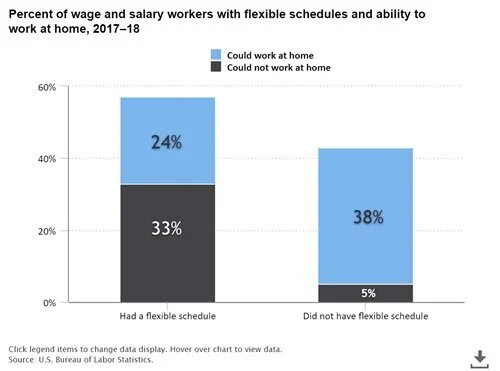Will managers finally embrace “work from home”?
In 2015, the US Bureau of Labor and Statistics reported that 24% of people worked from home. That’s up from 19% from 12 years earlier.
In addition, in 2017-2018, 29% of wage and salary workers could work at home in their primary job but only 25% of those chose to do so.
According to Figure 1, 62% of the total workforce could work from home if allowed.
If I’m doing my math right, there’s still an additional 33-37% of the workforce that could work from home but aren’t. Imagine the litany of benefits that could be realized (operational cost, commute time, pollution, etc.) if we could simply increase the work from home population by another 15%!
And yet, with all the new tools and technologies that have been widely deployed in the last 12+ years, why aren’t more people working from home?
Is it an aversion to change?
Possibly, but as change averse as most people are, I don’t believe this is the primary or only reason to resist the move towards working from home (WFH); at least not at the individual management level. I do, however, believe that concerns over the impact on company culture are valid and should be considered when offering WFH.
Is it a control and trust issue?
Yes, control and trust are clearly reasons for WFH avoidance but the genesis of avoidance stems from two main things, work culture and management style.
Work culture, in the 20th century, taught managers to value their worth and effectiveness by how well they could give direction and taskmaster; placing expectations on them to micro-manage. Of course, this could only be done if you could control work hours and work location. Without that control and physical presence, it just wasn’t possible to achieve results, or so the managers thought.
Management styles or “tendencies” affect the willingness to embrace new ways of working. Management styles tend to be either “Directive” or “Supportive”, with multiple combinations of both. Directive managers are highly directive but not necessarily supportive (some may call these micro-managers). Supportive managers usually provide minimal direction but are highly supportive (hands off style).
The focus must be on results! Little else matters!
When an older work culture is combined with management tendencies that are directive and inflexible, there’s little chance working from home or the local Starbucks will be allowed and a very good chance that any flexibility you are given will be short lived or forced upon managers by circumstances they cannot control (COVID19, HR, illness, etc).
Even today during the virus pandemic I know of instances where staff are working remotely but their companies are requiring them to be in an online chat room at 8am and only leaving during lunch; returning immediately after an hour later. Why are managers doing this? Yes, they want control and yes, they fear giving you more freedom will relinquish that control but they are killing creativity in the process and if WFH means this is the idea of flexibility, they’ll certainly push some of their best people out the door. The old saying, “people don’t leave companies, they leave bad management” speaks for itself.
The more mature an organization and its managers are in their ability to empower people and focus on results, the more likely they are to give employees the flexibility to work from home without restriction.
What’s next?
There’s a glimmer of hope beyond COVID19. We’re in the middle of the largest science project ever seen. There will be data and analysis on every front and maybe with empirical data, executives will finally take a hard look at the real results from their teams and move the needle even closer to the 62%.
The lockdowns have proven that work can get done and people can be productive; in fact, even more so from the home office. The benefits will outweigh the fear and control requirements of resistant management and they’ll have no choice but to embrace WFH in the future.

